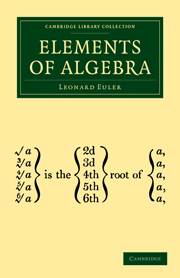Book contents
- Frontmatter
- ADVERTISEMENT
- MEMOIR OF THE LIFE AND CHARACTER OF EULER, BY THE LATE FRANCIS HORNER, ESQ., M. P.
- ADVERTISEMENT BY THE EDITORS OF THE ORIGINAL, IN GERMAN
- ADVERTISEMENT BY M. BERNOULLI, THE FRENCH TRANSLATOR
- Contents
- PART I Containing the Analysis of Determinate Quantities
- SECTION I Of the Different Methods of calculating Simple Quantities
- SECTION II Of the different Methods of calculating Compound Quantities
- SECTION III Of Ratios and Proportions
- SECTION IV Of Algebraic Equations, and of the Resolution of those Equations
- Chap. I Of the Solution of Problems in General
- Chap. II Of the Resolution of Simple Equations, or Equations of the First Degree
- Chap. III Of the Solution of Questions relating to the preceding Chapter
- Chap. IV Of the Resolution of two or more Equations of the First Degree
- Chap. V Of the Resolution of Pure Quadratic Equations
- Chap. VI Of the Resolution of Mixed Equations of the Second Degree
- Chap. VII Of the Extraction of the Roots of Polygonal Numbers
- Chap. VIII Of the Extraction of Square Roots of Binomials
- Chap. IX Of the Nature of Equations of the Second Degree
- Chap. X Of Pure Equations of the Third Degree
- Chap. XI Of the Resolution of Complete Equations of the Third Degree
- Chap. XII Of the Rule of Cardan, or that of Scipio Ferreo
- Chap. XIII Of the Resolution of Equations of the Fourth Degree
- Chap. XIV Of the Rule of Bombelli, for reducing the Resolution of Equations of the Fourth Degree to that of Equations of the Third Degree
- Chap. XV Of a new Method of resolving Equations of the Fourth Degree
- Chap. XVI Of the Resolution of Equations by Approximation
- PART II Containing the Analysis of Indeterminate Quantities
- ADDITIONS BY M. DE LA GRANGE
Chap. V - Of the Resolution of Pure Quadratic Equations
Published online by Cambridge University Press: 05 July 2011
- Frontmatter
- ADVERTISEMENT
- MEMOIR OF THE LIFE AND CHARACTER OF EULER, BY THE LATE FRANCIS HORNER, ESQ., M. P.
- ADVERTISEMENT BY THE EDITORS OF THE ORIGINAL, IN GERMAN
- ADVERTISEMENT BY M. BERNOULLI, THE FRENCH TRANSLATOR
- Contents
- PART I Containing the Analysis of Determinate Quantities
- SECTION I Of the Different Methods of calculating Simple Quantities
- SECTION II Of the different Methods of calculating Compound Quantities
- SECTION III Of Ratios and Proportions
- SECTION IV Of Algebraic Equations, and of the Resolution of those Equations
- Chap. I Of the Solution of Problems in General
- Chap. II Of the Resolution of Simple Equations, or Equations of the First Degree
- Chap. III Of the Solution of Questions relating to the preceding Chapter
- Chap. IV Of the Resolution of two or more Equations of the First Degree
- Chap. V Of the Resolution of Pure Quadratic Equations
- Chap. VI Of the Resolution of Mixed Equations of the Second Degree
- Chap. VII Of the Extraction of the Roots of Polygonal Numbers
- Chap. VIII Of the Extraction of Square Roots of Binomials
- Chap. IX Of the Nature of Equations of the Second Degree
- Chap. X Of Pure Equations of the Third Degree
- Chap. XI Of the Resolution of Complete Equations of the Third Degree
- Chap. XII Of the Rule of Cardan, or that of Scipio Ferreo
- Chap. XIII Of the Resolution of Equations of the Fourth Degree
- Chap. XIV Of the Rule of Bombelli, for reducing the Resolution of Equations of the Fourth Degree to that of Equations of the Third Degree
- Chap. XV Of a new Method of resolving Equations of the Fourth Degree
- Chap. XVI Of the Resolution of Equations by Approximation
- PART II Containing the Analysis of Indeterminate Quantities
- ADDITIONS BY M. DE LA GRANGE
Summary
623. An equation is said to be of the second degree, when it contains the square, or the second power, of the unknown quantity, without any of its higher powers; and an equation, containing likewise the third power of the unknown quantity, belongs to cubic equations, and its resolution requires particular rules.
624. There are, therefore, only three kinds of terms in an equation of the second degree:
The terms in which the unknown quantity is not found at all, or which is composed only of known numbers.
The terms in which we find only the first power of the unknown quantity.
The terms which contain the square, or the second power, of the unknown quantity.
So that x representing an unknown quantity, and the letters a, b, c, d, &c. the known quantities, the terms of the first kind will have the form a, the terms of the second kind will have the form bx, and the terms of the third kind will have the form cx2.
625. We have already seen, how two or more terms of the same kind may be united together, and considered as a single term.
For example, we may consider the formula ax2 − bx2 + cx2 as a single term, representing it thus, (a − b + c)x2; since, in fact, (a − b + c) is a known quantity.
- Type
- Chapter
- Information
- Elements of Algebra , pp. 216 - 222Publisher: Cambridge University PressPrint publication year: 2009First published in: 1822

